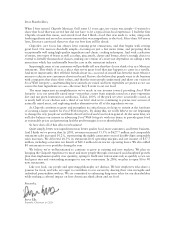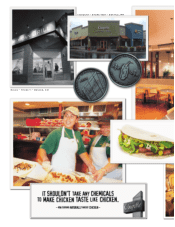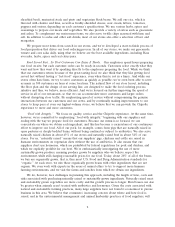Chipotle 2005 Annual Report Download - page 9
Download and view the complete annual report
Please find page 9 of the 2005 Chipotle annual report below. You can navigate through the pages in the report by either clicking on the pages listed below, or by using the keyword search tool below to find specific information within the annual report.foster demand for these foods. We believe that increased demand for naturally raised meat and
produce will in turn attract the interest and capital investment of larger farms and suppliers. That said,
we understand that we’ll continue to be at the forefront of this trend and must balance our interest in
advancing ‘‘food with integrity’’ with our desire to provide great food at reasonable prices. If our focus
resonates with consumers, it should improve our sourcing flexibility, although we would expect that
these ingredients and other raw materials will remain more expensive than commodity-priced
equivalents for some time to come.
Making and Selling ‘‘One Burrito At A Time’’: Store Management And Operations
People With Passion. We value the individuality of our company, our employees and our
customers, which we believe results in a management, operations and training philosophy distinct from
that of our competitors. We make an effort to hire employees who share a passion for food, and who
will operate our stores in a way that is consistent with our high standards but that allows each of their
unique personalities and strengths to contribute to our success. We also produce training materials that
are thought provoking and which engage our employees, rather than providing rote, step-by-step scripts
or rigid policy manuals. Through our culture, diversity and language programs that we provide in all of
our markets, we teach English to Spanish-speaking workers and Spanish to English-speakers, which
helps staff to better serve customers and makes for tighter crews. This program helps encourage our
staff members to develop skills that will enhance their work experience and enrich their personal lives.
Importance of Methods and Culture. Although we have many stores, we believe that our departure
from the automated cooking techniques used by many of our competitors sets our vision and our food
apart. Our crews use classic professional cooking methods, including slicing, marinating and grilling our
meats and hand-chopping many of our vegetables, in kitchens resembling those of high-end restaurants.
Despite our more labor-intensive method of food preparation, we believe that we produce food with an
efficiency that enables us to compete effectively.
The Front Line is Key. Our store and kitchen designs intentionally place crew members ‘‘up front’’
with customers to reinforce our focus on service. All our store employees are encouraged to have
genuine interactions with customers no matter their specific job, whether preparing food or serving
customers during our busiest period. We focus on attracting and keeping people who can replicate that
experience for each customer ‘‘one burrito at a time.’’ We provide each customer with individual
attention and make every effort to respond to customer suggestions and concerns in a personal and
hospitable way. We believe our focus on creating a positive and interactive experience helps build
loyalty and enthusiasm for our brand among store managers, crew members and customers alike.
The Basics. Each store typically has a store manager, an assistant manager and an average of
approximately 22 full and part-time crew members. We generally have two shifts at our stores, which
helps us better predict our store payroll expenses and in return provides our employees with more
stable and predictable work hours. We tend to have more employees in our busier stores. We cross-
train our employees, with a view to creating depth of competency in our critical store functions.
Consistent with our emphasis on customer contact, we encourage our store managers and crew
members to welcome and interact with customers throughout the day. And although they may increase
our labor costs, we believe that the benefits we provide to our employees, which include language
training and our company car program for longer-term store managers, help us to attract and keep
good store managers and crew members.
In addition to the employees serving our customers at each store, we also have area managers
(responsible on average for about six stores each) and operations directors (responsible on average for
about 50 stores each). Our four regional directors (who report to our President and Chief Operating
Officer) each supervise between one to four operations directors.
3






















